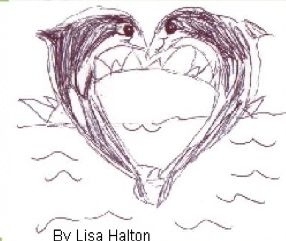Hi, my name is Douglas! I am an Hourglass Dolphin, or if you want to be fancy about it a Lagenorhynchus cruciger. My friends usually call me the “sea cow” because of my colors. Sometimes it hurts my feelings, so I like to be called by my real name. I’m black all over with patches of white above my eye and beak and my flippers. Why am I called the ‘hourglass dolphin’? Because a strip of white connects all of these patches so it looks like an hourglass! I’m a little small though. When I’m fully grown, I’m 1.8m (5.9 ft) in length. I weigh 90-120 kg.
Specific Habitat
I prefer to live and roam around the cold arctic waters of north Antarctica. I have some friends that live in the South of New Zealand around the South Shetland Islands! Hourglass dolphins are also usually seen far out to sea, but some can be found around southern South America near Tierra del Fuego, Argentina. We are mainly spotted in areas north and south of the Antarctic Convergence linking South America and Macquarie Island. We like cold habitats but with warmer surface temperatures since we usually stay fairly close to the surface near islands and banks.
Specific Adaptations to the Environment
As dolphins, we adapt to our environment in many different ways, one being echolocation. Echolocation is a mixture of sounds that assist us dolphins in communication. It is also used to locate prey, other dolphins, predators, or a lost baby. It helps us dolphins to become familiar with our surroundings and to communicate with each other. As a specialist, I can tell you that we make up to 68 different clicking sounds. Dolphin echolocation works for both sending and receiving the signals needed to get the information we want. The information that we would usually be looking for would most commonly be obstacles or predators and prey.
Dolphins also adapt to the environments because we all have a layer of blubber (body fat). The thickness of blubber is different in each species. The colder the environment, the more blubber a dolphin has. This layer of fat lets us keep a steady body temperature even if we are live in freezing cold water.
Reproductive Characteristics
Hourglass dolphins are pregnant for nearly an entire year, but other than that, little is really known about the hourglass dolphin’s reproductive characteristics.
Classification
- Kingdom: Animalia
- Phylum: Chordata
- Class: Mammalia
- Order: Cetacea
- Family: Delphinidae
- Genus: Lagenorhynchus
- Species: Lagenorhynchus cruciger
An hourglass dolphin is classified under the Animalia kingdom. It is multicellular, and the cells have a nucleus. The dolphin’s body develops over time and becomes set as they grow. Dolphins are able to move independently which is a characteristic of most creatures in the Animalia kingdom. Mammalia are a subgroup of vertebrate animals, which are a subgroup of Chordata. Mammalia have sweat glands that can produce milk. The Mammalia also possess specialized teeth that help dolphins catch their prey. Eutheria is a subgroup of Mammalia. Before the dolphin is born it is nourished during its development by a placenta inside the mother dolphin. Cetacea is a group of mammals that are almost fully adapted to life under water, meaning they have a spindle-shaped body, flippers and vestigial hindlimbs. This word, in Latin, means “whale” or “large sea animal”. Delphindae classifies animals that normally live in groups, use echolocation to find food and to find their way in the water. Dolphins have also been described as highly intelligent.
Our Importance to the Ecosystem
Of course we’re important to the ecosystem! We control the population of salmon and tuna, and shrimp. Without us there would be a lot more fish which could lead to overpopulation in certain areas.
Are We Endangered?
There are three major causes for the endangerment of dolphins. The first cause is because dolphins and tuna tend to stick close to each other and follow the same course through the oceans or rivers. Because of this dolphins get trapped in fishermen's netting which is designed to catch tuna. When this happens we get badly injured or drown.
The second reason is humans and fishing in general. There are laws now against fishing for dolphins, but around 200,000- 500,000 dolphins were caught in a span of 12 years.
The third and one of the most harmful causes for our endangerment is pretty obvious: pollution. Humans have been polluting rivers and oceans, for many years now, and the effect really hurts us dolphins. Since we’re high up in the food chain, the chemicals that pollute our environment concentrate in our body which cause diseases, trouble reproducing or even death in some cases.
All of these causes for our endangerment are related to humans. Although we are not listed as an endangered species, we are very rare, and it is very rare that we are spotted because we avoid coming too close to the surface. The fact that the we are timid and stay away from people may be one of the main reasons why we are not yet an endangered species.




 Go to quick links
Go to quick search
Go to navigation for this section of the ToL site
Go to detailed links for the ToL site
Go to quick links
Go to quick search
Go to navigation for this section of the ToL site
Go to detailed links for the ToL site